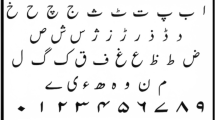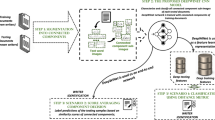Abstract
In modern societies, handwritten identification is a great practical need and challenge for forensic sciences. Moreover, few research studies have focused on automatic offline handwritten document analysis. Also, there are very few standard datasets on handwritten document identification. In addition, handwritten documents lose their nature over time due to the spread and drying of ink. From this standpoint, the present study presents an offline writer identification system (in presence of the uncertainties such as different experimental conditions and environmental noises for more realistic assumptions) that is a critical need in forensic studies. For this purpose, a comprehensive right-to-left dataset is developed and devised by gathering data from 62 participants at different time intervals under different experimental conditions. This dataset is designed based on American Society for Testing and Materials (ASTM) standards. A Deep Convolutional Neural Network (DCNN) model based on modified pre-trained networks is designed and developed to extract features from raw data hierarchically. The proposed DCNN model is tested and investigated not only on the designed dataset but also on different datasets. One notable advantage of the present study is that it has made use of heterogeneous data. Another remarkable aspect of the proposed study is that the proposed DCNN model is independent of any specific languages which can be applied on various languages. The results of the study indicate that the proposed DCNN model can learn features hierarchically from the handwriting raw data and achieve higher accuracy than other comparative methods.

















Similar content being viewed by others
References
Adak C, Chaudhuri BB, Blumenstein M (2019) An empirical study on writer identification and verification from intra-variable individual handwriting. IEEE Access 7:24738–24758
Ahmed AA, Hasan HR, Hameed FA, Al-Sanjary OI (2017) Writer identification on multi-script handwritten using optimum features. Kurd J Appl Res 2(3):178–185
Akiba T, Suzuki S, Fukuda K (2017) Extremely large minibatch sgd: Training resnet-50 on imagenet in 15 minutes. arXiv:1711.04325
Amin-Naji M, Aghagolzadeh A, Ezoji M (2020) CNNs hard voting for multi-focus image fusion. J Ambient Intell Human Comput 11:1749–1769. https://doi.org/10.1007/s12652-019-01199-0
Baghshah MS, Shouraki SB, Kasaei S (2006) A novel fuzzy classifier using fuzzy LVQ to recognize online Persian handwriting. In: 2006 2nd international conference on information & communication technologies, vol 1. IEEE, pp 1878–1883
Barratt S, Sharma R (2018) A note on the inception score. arXiv:1801.01973
Bennour A, Djeddi C, Gattal A, Siddiqi I, Mekhaznia T (2019) Handwriting based writer recognition using implicit shape codebook. Forensic Sci Int 301:91–100
Bottou L (2010) Large-scale machine learning with stochastic gradient descent. In: Proceedings of COMPSTAT'2010, Physica-Verlag HD, pp 177–186
Bulacu M, Schomaker L (2007) Text-independent writer identification and verification using textural and allographic features. IEEE Trans Pattern Anal Mach Intell 29(4):701–717
Burges C, Shaked T, Renshaw E, Lazier A, Deeds M, Hamilton N, Hullender G (2005) Learning to rank using gradient descent. In: Proceedings of the 22nd international conference on Machine learning, pp 89–96
Carbune V, Gonnet P, Deselaers T, Rowley HA, Daryin A, Calvo M, Wang L-L, Keysers D, Feuz S, Gervais P (2020) Fast multi-language LSTM-based online handwriting recognition. Int J Doc Anal Recogn (IJDAR) 23(2):89–102
Chahi A, Ruichek Y, Touahni R (2018) Block wise local binary count for off-line text-independent writer identification. Expert Syst Appl 93:1–14
Christlein V, Maier A (2018) Encoding CNN activations for writer recognition. In: 2018 13th IAPR International workshop on document analysis systems (DAS), IEEE, pp 169–174
Coleman C, Kang D, Narayanan D, Nardi L, Zhao T, Zhang J, Zaharia M (2019) Analysis of dawnbench, a time-to-accuracy machine learning performance benchmark. ACM SIGOPS Oper Syst Rev 53(1):14–25
Dang Y, Anand D, Sethi A (2019) Pixel-wise Segmentation of Right Ventricle of Heart. In: TENCON 2019–2019 IEEE Region 10 Conference (TENCON), IEEE, pp 1797–1802
Domingos P (2000) Bayesian averaging of classifiers and the overfitting problem. ICML 747:223–230
DoubleApaper (2017) http://igepa-allcart.com/myuploads/WDAcjSnxTpKf2iBf1415718830.pdf
Durou A, Aref I, Al-Maadeed S, Bouridane A, Benkhelifa E (2019) Writer identification approach based on bag of words with OBI features. Inf Process Manag 56(2):354–366
E2290-07a (2007) A Standard Guide for examination of handwritten items, in ASTM International. West Conshohocken
Eltay M, Zidouri A, Ahmad I (2020) Exploring deep learning approaches to recognize handwritten arabic texts. IEEE Access 8:89882–89898
Faber-Castell (2017) http://www.faber-castell.in/40526/Products/Exports/default_news.aspx
Garg NK, Kumar M (2018) Writer identification system for handwritten Gurmukhi characters: Study of different feature-classifier combinations. In: Proceedings of international conference on computational intelligence and data engineering, Springer, Singapore, pp 125–131
Ghanim TM, Khalil MI, Abbas HM (2020) Comparative study on deep convolution neural networks DCNN-based offline Arabic handwriting recognition. IEEE Access 8:95465–95482
Goodfellow I, Bengio Y, Courville A, Bengio Y (2016) Deep learning, vol 1. MIT press, Cambridge
Gu J, Wang Z, Kuen J, Ma L, Shahroudy A, Shuai B, Chen T (2018) Recent advances in convolutional neural networks. Pattern Recogn 77:354–377
Hafemann LG, Sabourin R, Oliveira LS (2019) Characterizing and evaluating adversarial examples for offline handwritten signature verification. IEEE Trans Inf Forensics Secur 14(8):2153–2166
Hagan MT, Demuth HB, Beale MH (1996) Neural network design. PWS, Boston
Hannad Y, Siddiqi I, El Kettani MEY (2016) Writer identification using texture descriptors of handwritten fragments. Expert Syst Appl 47:14–22
Hannad Y, Siddiqi I, Djeddi C, El-Kettani MEY (2019) Improving Arabic writer identification using score-level fusion of textural descriptors. IET Biometrics 8(3):221–229
Hassan AR, Bhuiyan MIH (2016) Computer-aided sleep staging using complete ensemble empirical mode decomposition with adaptive noise and bootstrap aggregating. Biomed Signal Process Control 24:1–10
Hawkins DM (2004) The problem of overfitting. J Chem Inf Comput Sci 44(1):1–12
He S, Schomaker L (2019) Deep adaptive learning for writer identification based on single handwritten word images. Pattern Recognit 88:64–74
Hinton GE, Srivastava N, Krizhevsky A, Sutskever I, Salakhutdinov RR (2012) Improving neural networks by preventing co-adaptation of feature detectors. arXiv:1207.0580
Huang G, Liu S, Van der Maaten L, Weinberger KQ (2018) Condensenet: An efficient densenet using learned group convolutions. In: Proceedings of the IEEE conference on computer vision and pattern recognition, pp 2752–2761
Hung SL, Adeli H (1993) Parallel backpropagation learning algorithms on Cray Y-MP8/864 supercomputer. Neurocomputing 5(6):287–302
Iandola F, Moskewicz M, Karayev S, Girshick R, Darrell T, Keutzer K (2014) Densenet: Implementing efficient convnet descriptor pyramids. arXiv:1404.1869
Jain AK, Bolle R, Pankanti S (eds) (2006) Biometrics: personal identification in networked society, vol 479. Springer Science & Business Media, Berlin
Johnson R, Zhang T (2013) Accelerating stochastic gradient descent using predictive variance reduction. Adv Neural Inf Process Syst 26:315–323
Karouni A, Daya B, Bahlak S (2011) Offline signature recognition using neural networks approach. Proc Comput Sci 3:155–161
Khan FA, Tahir MA, Khelifi F, Bouridane A, Almotaeryi R (2017) Robust off-line text independent writer identification using bagged discrete cosine transform features. Expert Syst Appl 71:404–415
Kingma DP, Ba J (2014) Adam: a method for stochastic optimization. arXiv:1412.6980
Kleber F, Fiel S, Diem M, Sablatnig R (2013) Cvl-database: An off-line database for writer retrieval, writer identification and word spotting. In: 2013 12th international conference on document analysis and recognition, IEEE, pp 560–564
Kutzner T, Pazmiño-Zapatier CF, Gebhard M, Bönninger I, Plath WD, Travieso CM (2019) Writer identification using handwritten cursive texts and single character words. Electronics 8(4):391
Mahmoud SA, Luqman H, Al-Helali BM, BinMakhashen G, Parvez MT (2018) Online-khatt: an open-vocabulary database for Arabic online-text processing. Open Cybern Syst J 12:42–59
Marti UV, Bunke H (2002) The IAM-database: an English sentence database for offline handwriting recognition. Int J Doc Anal Recogn 5(1):39–46
Mousavi Z, Rezaii TY, Sheykhivand S, Farzamnia A, Razavi SN (2019) Deep convolutional neural network for classification of sleep stages from single-channel EEG signals. J Neurosci Methods 324:108312
Mousavi Z, Ettefagh MM, Sadeghi MH, Razavi SN (2020a) Developing deep neural network for damage detection of beam-like structures using dynamic response based on FE model and real healthy state. Appl Acoust 168:107402
Mousavi Z, Varahram S, Ettefagh MM, Sadeghi MH, Razavi SN (2020b) Deep neural networks–based damage detection using vibration signals of finite element model and real intact state: An evaluation via a lab-scale offshore jacket structure. Structural Health Monitoring, p. 1475921720932614.
Pechwitz M, Maddouri SS, Märgner V, Ellouze N, Amiri H (2002) IFN/ENIT-database of handwritten Arabic words. . Proc CIFED Citeseer 2:127–136
Pokhriyal N, Tayal K, Nwogu I, Govindaraju V (2016) Cognitive-biometric recognition from language usage: a feasibility study. IEEE Trans Inf Forensics Secur 12(1):134–143
Rehman A, Naz S, Razzak MI, Hameed IA (2019) Automatic visual features for writer identification: a deep learning approach. IEEE Access 7:17149–17157
Rosasco L, Vito ED, Caponnetto A, Piana M, Verri A (2004) Are loss functions all the same? Neural Comput 16(5):1063–1076
Saba T (2018) Fuzzy ARTMAP approach for arabic writer identification using novel features fusion. J Comput Sci 14(2):210–220
Said HE, Tan TN, Baker KD (2000) Personal identification based on handwriting. Pattern Recogn 33(1):149–160
Santos P, Villa LF, Reñones A, Bustillo A, Maudes J (2015) An SVM-based solution for fault detection in wind turbines. Sensors 15(3):5627–5648
Schneiderpen (2017) https://schneiderpen.com/en_us/office/tops-505-black-f-4004675004529.pdf/
Shahabi F, Rahmati M (2009) A new method for writer identification of handwritten Farsi documents. In: 2009 10th International conference on document analysis and recognition. IEEE, pp 426–430
Sheykhivand S, Mousavi Z, Rezaii TY, Farzamnia A (2020a) Recognizing emotions evoked by music using CNN-LSTM networks on EEG signals. IEEE Access 8:139332–139345
Sheykhivand S, Rezaii TY, Mousavi Z, Delpak A, Farzamnia A (2020b) Automatic identification of epileptic seizures from EEG signals using sparse representation-based classification. IEEE Access 8:138834–138845
Sheykhivand S, Mousavi Z, Mojtahedi S, Rezaii TY, Farzamnia A, Meshgini S, Saad I (2021) Developing an efficient deep neural network for automatic detection of COVID-19 using chest X-ray images. Alex Eng J 60(3):2885–2903
Shreekanth T, Kumar MP, Krishnan A (2018) Text-independent handwriting classification using line and texture-based features. International conference on ISMAC in computational vision and bio-engineering. Springer, Cham, pp 211–220
Srihari SN, Cha SH, Arora H, Lee S (2002) Individuality of handwriting. J Forensic Sci 47(4):1–17
Steyerberg EW (2019) Overfitting and optimism in prediction models. Clinical prediction models. Springer, Cham, pp 95–112
Szegedy C, Ioffe S, Vanhoucke V, Alemi A (2017) Inception-v4, inception-resnet and the impact of residual connections on learning. In: Proceedings of the AAAI conference on artificial intelligence 31(1)
Tang P, Wang H, Kwong S (2017) G-MS2F: GoogLeNet based multi-stage feature fusion of deep CNN for scene recognition. Neurocomputing 225:188–197
Wahlberg F (2018) Gaussian process classification as metric learning for forensic writer identification. In: 2018 13th IAPR International workshop on document analysis systems (DAS), IEEE, pp 175–180
Wójcik B, Maziarka Ł, Tabor J (2019) LOSSGRAD: automatic learning rate in gradient descent. arXiv:1902.07656
Wu X, Tang Y, Bu W (2014) Offline text-independent writer identification based on scale invariant feature transform. IEEE Trans Inf Forensics Secur 9(3):526–536
Wu Z, Shen C, Van Den Hengel A (2019) Wider or deeper: revisiting the resnet model for visual recognition. Pattern Recogn 90:119–133
Xing L, Qiao Y (2016) Deepwriter: a multi-stream deep CNN for text-independent writer identification. In: 2016 15th international conference on frontiers in handwriting recognition (ICFHR), IEEE, pp 584–589
Zhang XY, Xie GS, Liu CL, Bengio Y (2016) End-to-end online writer identification with recurrent neural network. IEEE Trans Hum Mach Syst 47(2):285–292
Zhang W, Li C, Peng G, Chen Y, Zhang Z (2018) A deep convolutional neural network with new training methods for bearing fault diagnosis under noisy environment and different working load. Mech Syst Signal Process 100:439–453
Author information
Authors and Affiliations
Corresponding author
Additional information
Publisher's Note
Springer Nature remains neutral with regard to jurisdictional claims in published maps and institutional affiliations.
Rights and permissions
About this article
Cite this article
Khosroshahi, S.N.M., Razavi, S.N., Sangar, A.B. et al. Deep neural networks-based offline writer identification using heterogeneous handwriting data: an evaluation via a novel standard dataset. J Ambient Intell Human Comput 13, 2685–2704 (2022). https://doi.org/10.1007/s12652-021-03253-2
Received:
Accepted:
Published:
Issue Date:
DOI: https://doi.org/10.1007/s12652-021-03253-2




